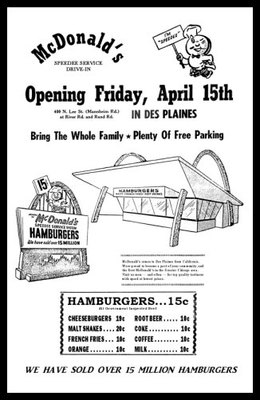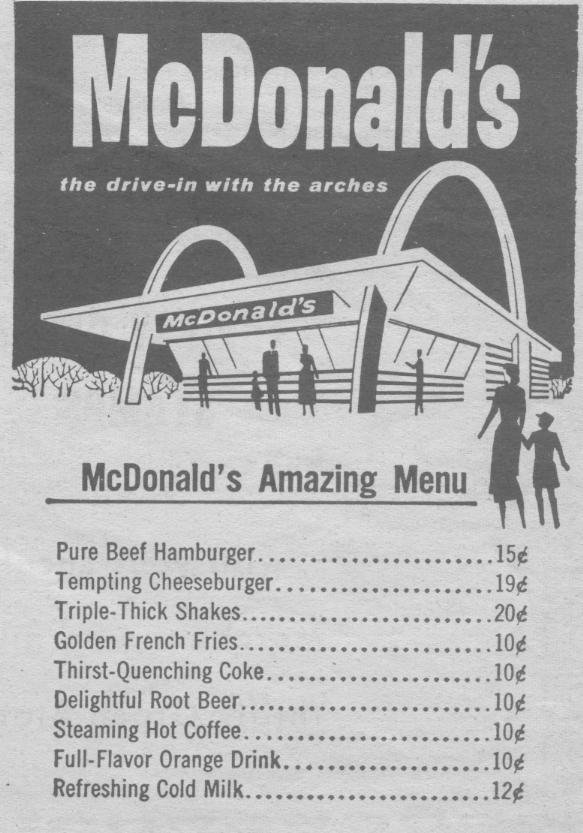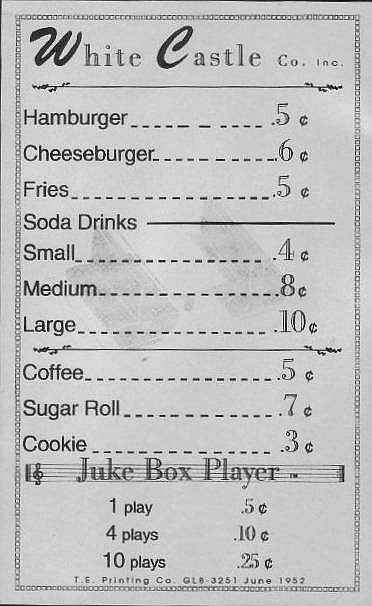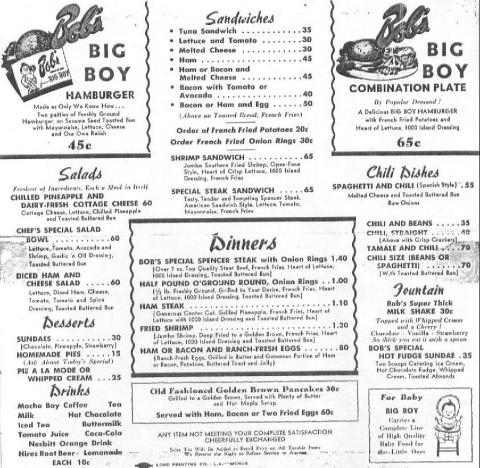1 Des
Plaines Journal, “McDonald's Advertisement,” April 14,
1955, 8. Advertisement is also available at
http://www.amusingplanet.com/2012/09/worlds-first-mcdonald-restaurant.html.
2 Rick
Schlosser,
Fast-Food Nation: The Dark Side of the All-American
Meal (New York: Houghton Mifflin Company, 2001), 16.
3 John
F. Love,
McDonald's: Behind the Arches, rev. ed. (New York:
Bantam Books, 1995), 19.
4 John
C. Super, “Food and History,”
Journal of Social
History 36, no. 1 (2002).
5 John
Guarini, “McDonald's First Location in San Bernardino,”
Huffington Post, last modified October 10, 2012,
http://www.huffingtonpost.com/2012/10/04/mcdonalds-first-location_n_1940249.html.
6 Love,
41-42.
7 Schlosser,
9.
8 Ray
Kroc,
Grinding it Out: The Making of McDonald's, ed. Robert
Anderson, rev. ed. (Chicago: Contemporary Books, 1987), 84.
9 Love,
18-19.
10 White
Castle Hamburger Menu: 1985, last modified September 28, 2009,
http://chuckmanplaces.wordpress.com/2009/09/28/white-castle-hamburger-menu-1952/.
11 Schlosser,
197-198.
12 Bob's
Big Big Boy Menu from the 50s, last modified August 5, 2006,
http://www.nhhs54.org/gallery/main.php? g2_itemId=1668.
13 Love,
114.
14 Love,
120.
15 Alan
Hess, “The Origin's of McDonald's Golden Arches,”
Journal of the Society of Architectural Historians 45, no. 1
(1986): 60-67.
16 Love,
130.
17 Schlosser,
120.
18 In
1990, amid a public barrage of criticism, McDonald's switched to
pure vegetable oil.
19 Ray
Kroc, quoted in John F. Love,
McDonald's: Behind the Arches,
rev. ed. (New York: Bantam Books, 1995), 121.
20 Schlosser,
6.
21 Margaret
Visser,
The Rituals of Dinner (New York: Penguin, 1991), 42.
22 Visser,
The Rituals of Dinner, 44.
23 Conrad
P. Kottak, “Rituals at McDonald's,”
Natural History
87, no. 1 (2002), 75.
24 Kottak,
75.
25 Margaret
Visser,
Much Depends on Dinner, 2
nd ed. (New York:
Grove Press, 2008), 118.
26 Kottak,
82.
27 Kottak,
82.
28 Visser,
Much Depends on Dinner, 119.
29 Johan
Goldberg, “The Specter of McDonald's: An Object of Bottomless
Hatred,”
National Review, June 5, 2000.
Bibliography:
Bob's Big Big Boy Menu from the 50s. Last modified
August 5, 2006.
http://www.nhhs54.org/gallery/main.php?g2_itemId=1668.
Des
Plaines Journal. “McDonald’s Advertisement.” April 14, 1955
http://www.amusingplanet.com/2012/09/worlds-first-mcdonald-restaurant.html.
Fischler, Claude. “Food, Self, and Identity.”
Social Science
Information 27, no. 2 (1988): 275-92.
Goldberg, Johan. “The Specter of McDonald's: An Object of
Bottomless Hatred.”
National Review. June 5, 2000, 29-32.
Guarini, Drew. “McDonald's First Location in San Bernardino.”
Huffington Post.
Last modified October 10, 2012. http://www.huffingtonpost.com/2012/10/04/mcdonalds-first-location_n_1940249.html.
Hess, Alan. “The Origins of McDonald's Golden Arches.”
Journal
of the Society
of Architectural Historians 45, no. 1 (1986): 60-67.
Kottak, Conrad P. “Rituals at McDonald's.”
Natural History
87, no. 1 (1978) 75-83.
Kroc, Ray. Grinding
it Out: The Making of McDonald's. Edited
by Robert
Anderson. Chicago: Contemporary Books Inc., 1987.
Love, John F.
McDonald's: Behind the Arches. Rev. Ed. New
York: Bantam Books, Revised Ed. 1995.
Ritzer, George. “The McDonaldization of Society.”
Journal of
American Culture 6, no. 1 (1983): 100-107.
Schlosser, Rick.
Fast-Food Nation: The Dark Side of the
All-American Meal. New
York: Houghton Mifflin Company, 2001.
Super, John C. “Food and History.”
Journal of Social History
36, no. 1 (2002): 165-178.
Visser, Margaret.
Much Depends on Dinner. New York: MacMillan,
1986.
...
The Rituals of Dinner.
New York: Penguin, 1991.
White
Castle Hamburger Menu: 1985. Last modified September 28, 2009.
http://chuckmanplaces.wordpress.com/2009/09/28/white-castle-hamburger-menu-1952/.
Questions? Comments?
Contact me and let me know!



